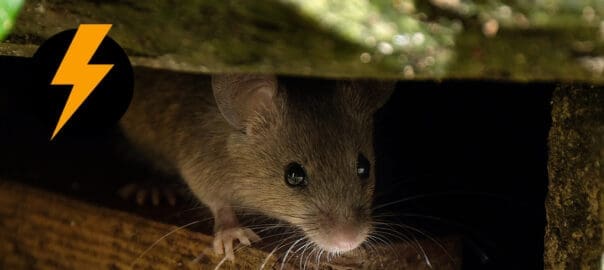Well, it’s finally happened. You’ve put months of effort into perfecting your lawn. Your garden is thriving, and your grass has never been greener. But one morning you wake up to find the dreaded mole mounds dotting your yard.
Now you’re wondering how to get rid of moles from your lawn. While you might be tempted to use a tried – and not-so-true – home remedy like chewing gum or car exhaust, now might be a good time to take a breath, identify the source of the moles, and leave the situation to the experts.
Moles in Oregon are a major problem, we know; we receive calls from customers with mole problems daily who want to know if moles can be controlled, and we’ve caught many, many moles. First, let’s take a moment to examine just what a mole is, why it does what it does to your lawn and how to remove moles from your lawn.
What Are Moles?

Contrary to popular belief, moles are not rodents, but insectivores. They’re more closely related to hedgehogs, shrews, and even anteaters than they are to gophers or other rodents. Most of the mole’s closest relatives either live underground or feed there. Moles can be active year-round and are known to occasionally push up a new mound even in snow! They do try to store food for the colder months when their activity will often be subdued, but moles are not above tunneling even in freezing temperatures.
Moles primarily feed on earthworms, beetle grubs, ants, and other arthropods and animals found in the soil. Moles eat just above the grass-root level, creating a trap door effect. As bugs and worms move through the loose soil, they fall into the tunnel system. The moles simply circle around the tunnel system and pick up food – a lot of food. Moles can eat up to a third of their body weight per day – up to 50 lbs of worms in a year! So although it may appear they are eating your plant and grass roots, moles are actually after worms, and in the process of feeding, they inadvertently kill the grass by separating the roots from the soil. In this regard, moles probably serve a check-and-balance role in soil ecosystems and in nature. Their tunnels also provide some aeration, and allow the rainwater to access some areas – and thus probably help to promote plant and tree growth.
When Are Moles Most Active?
You’ll probably notice most mole activity in the spring and fall, especially on damp days or following rain showers. This type of weather makes it easier for moles to tunnel or push up mounds. When the ground surface becomes frozen during winter – or very dry during summer – moles retreat to their deeper burrows. Do mole hibernate? This is a common misconception. Moles do not migrate or hibernate during winter. In fact, they remain active and are able to go undetected in the winter months.
Spring is also mating for moles. Mating occurs during February and March, with a single litter of three to five young born in late spring. Young moles grow rapidly, and they look and behave like adults at about one month old. Young moles may use their families’ burrow system for up to six months before dispersing to establish their own burrow system nearby. So if you notice increased mole mounds or tunnels during the spring, it might be a good idea to take action and contact your local mole removal experts.
Related: Taking Control of Springtime Pests in Oregon
The Facts on Mole Tunnels
While moles serve a vital role in the ecosystem, you probably still don’t want them hanging around your yard. Because once moles have created a tunnel system through your lawn, they’re on a roll – literally. The most prevalent type of mole in our region, the Townsend mole, can dig at a rate of 18 feet per hour. And if they are already inside a previously excavated tunnel, they can run up to 80 feet per minute – forward or backward – underground. And to make matters worse – yes, worse than 80 feet per minute – moles dig two types of tunnels, surface runways and deep runways:
- Surface runways are feeding tunnels just below the soil surface. They are commonly seen as the raised ridges running through lawn areas. Moles are capable of extending these runways by 100 feet per day! Subsurface runways may be used daily, revisited at irregular intervals, or may be used only once for feeding and then abandoned. Generally, few or no mounds are produced as the result of the production of subsurface runways.

- Deep runways are located between 3 to 12 inches below the surface. They are used daily as the moles travel to and from subsurface runways. The soil excavated from deep tunnels is deposited on the surface through short, vertical tunnels in volcano-like mounds. Mole mounds, unlike the gopher’s horseshoe-shaped mound with a central round plug, are round and lack any noticeable hole or plug.

Unfortunately, the number of mounds or subsurface runways cannot be used to estimate the number of moles infesting a lawn. Generally, one acre of lawn supports one to three moles at a time – and one mature mole can create a dozen mounds in one week.
Differences Between Moles and Gophers
While gophers prefer vegetation, moles prefer worms and grubs, and occasionally small insects. There are three types of moles in our region, but by far the most prevalent is the Townsend Mole. They range about 5-8 inches, depending somewhat on age, and they are the largest moles in North America. They can dig approximately 18 feet per hour, if needed, and if they are already inside a previously excavated tunnel, they can run up to 80 feet per minute forwards or backward underground. Moles in Oregon seldom leave the protection of their tunnels and do not venture above ground unless they have to (fear of a predator, such as a snake, or flooding of tunnels).
Gophers:
Gophers eat plant matter and unearthing their tunnels often reveals a cache of roots stripped from nearby plants. They often have a density of 30+ per acre and live in short linear tunnels often only 15 feet long. The main tunnel is easily detected due to a series of mounds in an approximate line. Frequently gophers are found on hillsides with dry rocky soil. Gopher mounds are easily identified by their horseshoe shape containing a round plug about three inches in diameter near the center of the mound.
Moles:
Moles seem to be the most evasive of home remedy controls. These little devils can each make hundreds of mounds per year and often only 6 are found per acre. They eat worms and traverse extensive tunnel systems containing deep (10-12″) and shallow (4″) tunnels. Their mounds look like little volcanoes and have an uncanny ability to tunnel along any hard landscaping surfaces like sidewalks or lawn edging.

Gopher Mounds

Mole Mounds
Call In The Mole Removal Experts
We get it: you’re frustrated and ready to try anything to remove moles from your yard. But we’re begging you to put down that bottle of Tabasco sauce. Common “home remedies” to mole infestations are usually ineffective – we’re looking at you, chewing gum, auto exhaust, and dryer sheets – but thankfully, our trained technicians are here to help. At Bug Zapper Pest Control, our trained technicians trap moles and gophers to remove them, with a 100% success rate. We provide mole removal services for city parks, commercial sites, and homeowners. Our success rate is 100%, and often we achieve complete mole eradication overnight or within a few days. And every mole removal service we provide is 100% guaranteed for three full months. So if you’re fed up trying to think like a mole, schedule an appointment with us today.
The first step to winning the war on moles and gophers is contacting us for a free estimate. We know how to get rid of moles and gophers promptly and expertly. Cleanout trapping service starts at $295 and is based on yard size and infestation density.
Contact us to learn more about mole removal and additional pest removal services Bug Zapper Pest Control provides.



 Termites in Oregon: Are Termites a Problem in Oregon?
Termites in Oregon: Are Termites a Problem in Oregon? Termites in Oregon: Are Termites a Problem in Oregon?
Termites in Oregon: Are Termites a Problem in Oregon? How Do Pests Get Into My House?
How Do Pests Get Into My House? Carpenter Ant Identification & Prevention Tips
Carpenter Ant Identification & Prevention Tips What Attracts Spiders?
What Attracts Spiders?